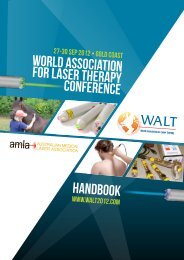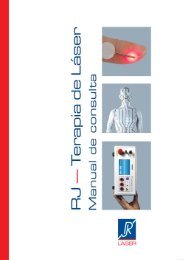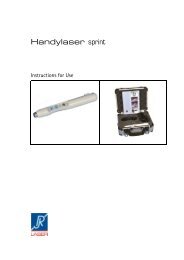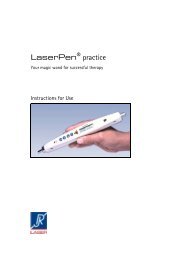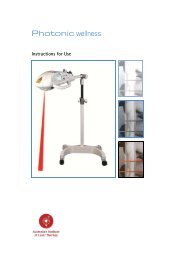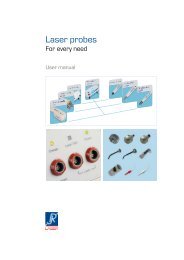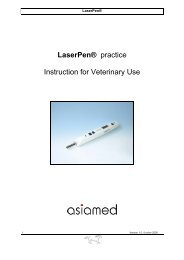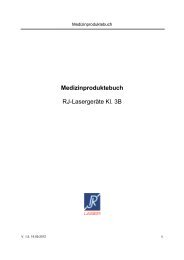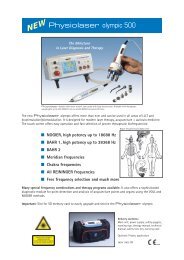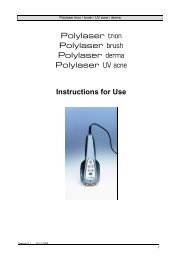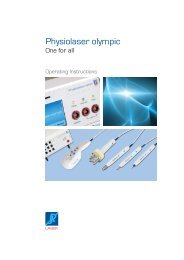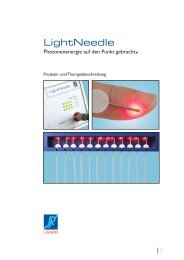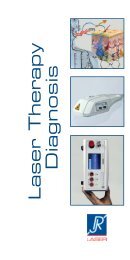LightNeedle - RJ Laser
LightNeedle - RJ Laser
LightNeedle - RJ Laser
You also want an ePaper? Increase the reach of your titles
YUMPU automatically turns print PDFs into web optimized ePapers that Google loves.
Gerhard Litscher<br />
Department 0( Biomedical Engineering and Research in Anesthesia and Critical Care, University 0( Graz, Austria<br />
This study comprises scientific-theoretic fundamental investi~ations of laserneedle@ technology, a new<br />
and painless method of acupuncture stimulation. <strong>Laser</strong>needlesfß> are not inserted in the skin, but are merely<br />
placed on the surface of the acupuncture point. The study documents the significant changes in peripheral<br />
microcirculation (p = 0.005) and surface temperature of the skin (p = 0.02) induced by laser, in 22 healthy<br />
volunteers (mean age 24.4:1: 2.6 years). In addition, a randomised cross-over study to characterise the<br />
specific changes in cerebral blood flow velocity with laserneedleil;) acupuncture (p < 0.001) is presented.<br />
These results provide important information for characterising the effects of laserneedleil;) acupuncture.<br />
[Neurol Res 2003; 25: 000-000] 2003, in press<br />
Keywords: <strong>Laser</strong>needlelgl acupuncture; High-Tech Acupuncturelgl; computer-controlled laserpuncture;<br />
transcranial Doppler sonography; near-infrared spectroscopy; laser Doppler flowmetry<br />
INTRODUCTION<br />
By stimulating acupuncture points with laserbeam and/<br />
or needles, specific effects can be achieved at the<br />
periphery and in the brain. For the first time, these effects<br />
can be characterised and quantified with modern<br />
biomedical equipment and cerebral monitoring<br />
methods 1-37.<br />
<strong>Laser</strong>needle@-acupuncture represents a new, painless<br />
method for primary optic stimulation of acupuncture<br />
points, whose effects were first described in international<br />
scientific literature in the year 20023,31-34,36,37. The goal<br />
of this stud~ is to convey current knowledge regarding<br />
laserneedle acupuncture from a theoretic-experimental<br />
point of view, based on the scientific studies<br />
mentioned above.<br />
METHODS<br />
The multi-parameter monitoring methods described in<br />
our study comprise investigations with laserneedle@<br />
acupuncture in regard to peripheral effects (temperature<br />
and microcirculation), as weil as central effects (blood<br />
flow velocity and regional cerebral oxygenation).<br />
<strong>Laser</strong>needle@.acupuncture<br />
Für the first time, laserneedle@ acupuncture allows<br />
the simultaneaus stimulation of individual acupuncture<br />
point combinations. Thus, variations and combinations<br />
of acupuncture points are possible on the body, ear or<br />
hand (Figure 1). More details regarding this method and<br />
its technical realisation can be found in previously<br />
publ ished stud iesJl-J4,J6,J7 .<br />
--<br />
Correspondence and reprint requests to: Prof. Dr G. Litscher,<br />
Departrnent of Biomedical Engineering and Research in Anesthesia<br />
and Critical Care, University of Graz, Auenbruggerplatz 29, A-8036<br />
Graz, Austria. [gerhard.litscher@uni-graz.at] Accepted for publication<br />
June2003.<br />
(C) 2003 Forefront Publishing Group<br />
0161-6412!03/00000{}-ü7<br />
Thermography<br />
The thermography system used in our study to<br />
determine surface temperature of the hand includes a<br />
Therma CAMTM P60 infrared camera (Flir Systems Inc.,<br />
Portland, OR, USA) in connection with a computeraided<br />
warmth visualisation system for real time video<br />
recording and analysis (Tracer Plus, Flir Systems Inc.).<br />
The infrared camera (distance to the measuring point<br />
on the hand 0.5 rn) was connected to a notebook via<br />
interface. For these investigations, a total of 20 min per<br />
volunteer with a resolution time of 3 min were registered<br />
and analysed. The registered temperatures were shown<br />
color-coded on a display which yielded color pictures of<br />
the color distribution.<br />
<strong>Laser</strong> Doppler flowmetry (LDF)<br />
A laser Doppler monitor DRT4 (Moor Instruments,<br />
Millwey, Axminster, England) was used to determine<br />
flux (product of concentration and velocity of erythrocytes)<br />
and temperature (selective measurement).<br />
Specified performance of the probe was 1 mW. Cutoff<br />
frequencies were 20 Hz and 22.5 kHz. The temperature<br />
measurement unit (5°C to sa°C) had a resolution of<br />
0.2°C. Several measurement probes are available for the<br />
DRT4 monitor. Derivatives documented in this study<br />
were performed with a DPIT probe (diameter 8 mm,<br />
length 7 mm).<br />
Mu'tidirectional transcrania' Doppler-sonography<br />
(TCD)<br />
In this study, Doppler sonographic signals were<br />
simultaneously registered in the left anterior cerebral<br />
artery (ACA) and the right posterior cerebral artery (PCA)<br />
with a Multi-Dop T System (DWL Elektronische Systeme<br />
GmbH, Sipplingen, Germany). Two 2-MHz probes were<br />
applied with a multi-functional construction2,11. Seg-<br />
Neurological Research, 2003, Volume 25,



